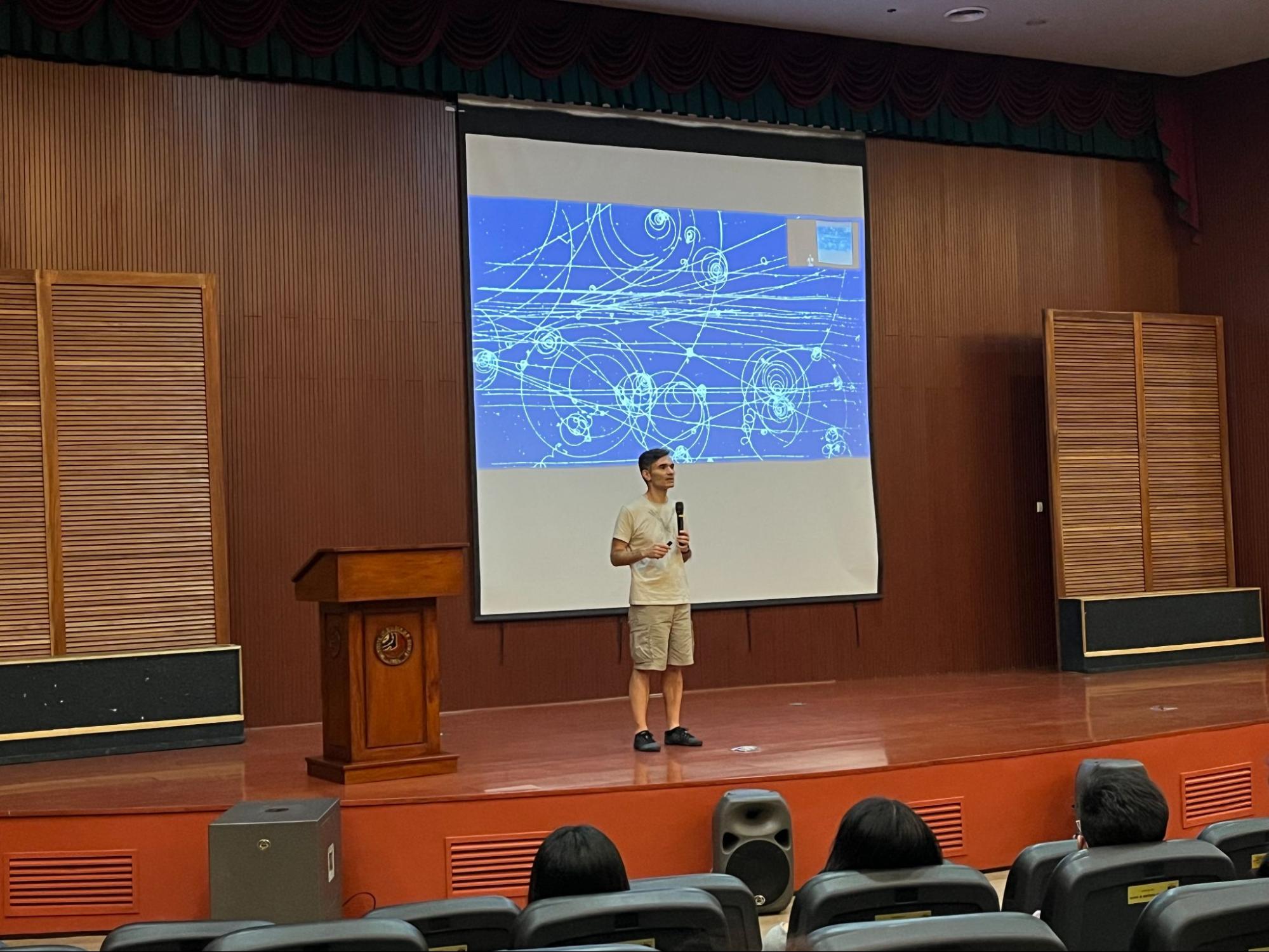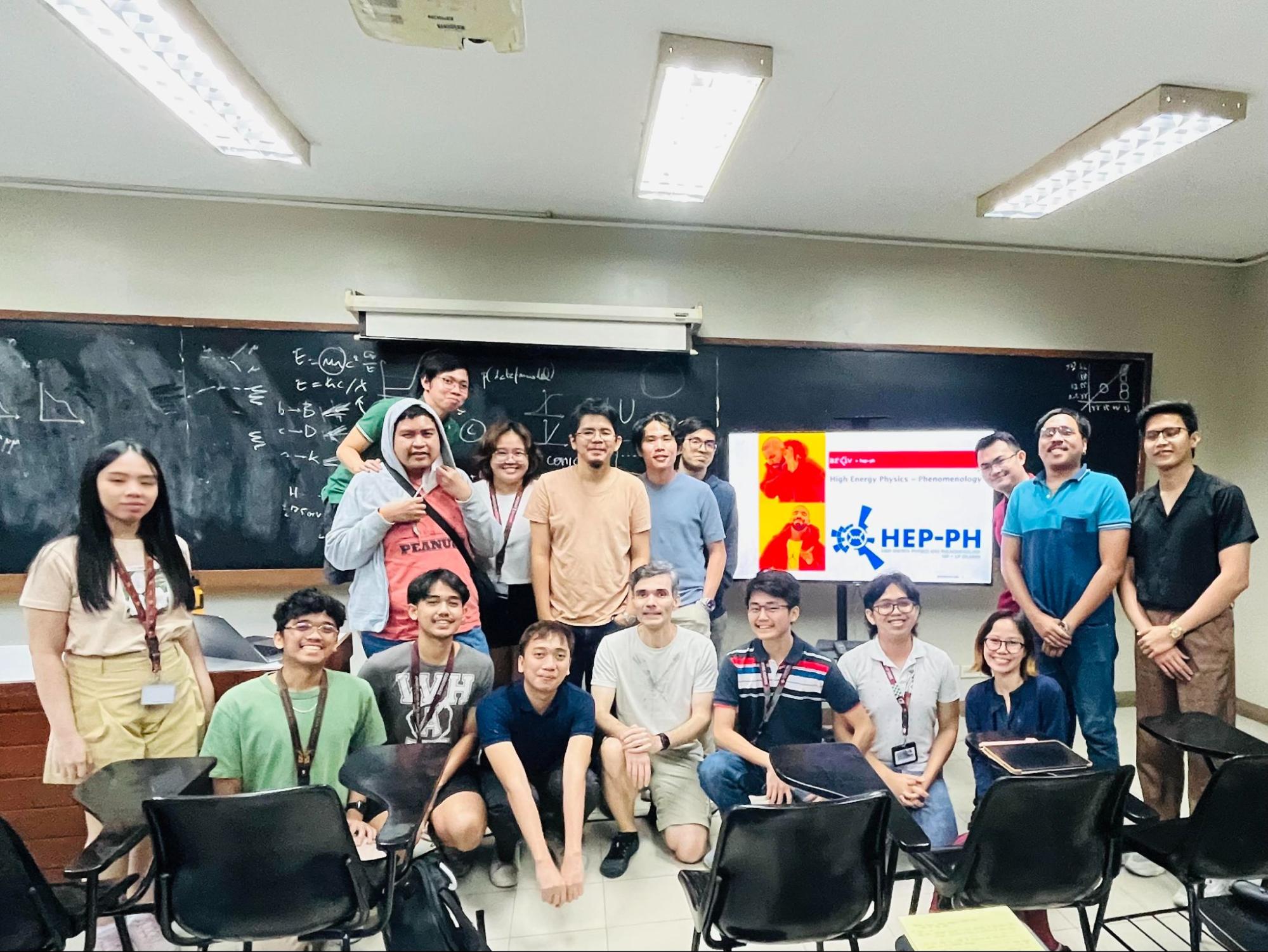Why Do Science? CERN Physicist Answers
Published: June 04, 2024
By: Harvey L. Sapigao

There are scientists whose works are immediately appreciated by people: molecular biologists and pharmaceutical scientists who develop medicines and vaccines and find cures for cancer; climatologists and environmental scientists who monitor the weather and fight climate change; engineers who invent thinner gadgets and faster electric cars. And then there are those like particle physicist Dr. André David, whose work veers into the more unfamiliar realms of science, the kinds that elicit unimpressed comments like “What for?” and “How will this help me in my everyday life?”.
Dr. David works at the European Organization for Nuclear Research, better known as CERN (Conseil Européen pour la Recherche Nucléaire), located on the border between Switzerland and France. But last February, he was at UPD College of Science (UPD-CS) giving a talk to students of the Science, Technology, and Society (STS) course about the very reason we do science. Judging solely from his familiarity with the weather (he wore khaki shorts and a beige shirt to reflect the heat) and his almost-natural interjections of parang and ano between his sentences, he is not unaccustomed to the Philippines.
Back at CERN, he and thousands of researchers from across the globe are demystifying the fundamental particles that make up the universe, particles much smaller and more elusive than the familiar protons and electrons. Using ring tunnels that span kilometers in diameter, called particle accelerators, they accelerate protons to near lightspeed and smash them together. The particles that unfurl from the collisions are what they study, revealing not only the most fundamental building blocks of matter but also the interactions that govern them.
In 2012, CERN announced the discovery of the Higgs boson, a particle that had eluded scientists since Peter Higgs theorized its existence in 1964 (Higgs sadly passed away on April 10, 2024). The Higgs boson gives particles their mass, allowing everything – stars, planets, life – to exist. Because of its significance, CERN’s discovery of the Higgs boson is considered one of the biggest scientific achievements in recent history.
But some still wonder why it’s even necessary to look for these particles, a sentiment that has only grown more prevalent after the discovery. Beyond the mental calisthenics and existential what-ifs, what has the Higgs boson contributed to our daily lives? Did it make our coffee taste better, our days cooler, our sleep deeper? One might even argue that there’s no discernible difference between their lives before and after knowing the Higgs boson exists.
When I asked Dr. David if he has one-liners in response, developed from having been confronted with these questions countless times, he was quick to clarify he doesn’t. “I’m no Richard Feynman,” he said. But in his lecture at UPD-CS, he had passingly said something that I thought, in hindsight, summed up his points succinctly: “You won’t see if you don’t look.”
That is, discoveries come from exploring the unknown, not from working on what’s already known, and “should you not seek, you are guaranteed to not find,” he explained to me. “The importance of new findings is that they can only be rendered useful if they are brought into the light of our collective knowledge. No amount of applied research on candles would have made the electric lightbulb possible.”
Indeed, when William Gilbert was investigating why amber attracts straws and chaff, he didn’t know he was laying the groundwork for what is now an essential component of our modern lives. He was examining how static electricity works and had devised the first electrical measuring instrument called the electroscope – a simple pivoted needle that revolves when drawn near a lightly rubbed amber. During his time (the 16th century), the world was run by horse-drawn carriages and manual labor. At the time, there were no apparent applications for the phenomenon that made amber sticky, nor would there be until 200 years later when Ewald Georg von Kleist and Pieter van Musschenbroek independently invented the Leyden jar, a device used to store electric charge. Even then, Gilbert’s, Kleist’s, and Musschenbroek’s works would not be fully realized until the 19th century, when inventors such as Alexander Graham Bell and Thomas Edison developed the first practically usable electric devices such as the telephone and the incandescent light bulb.
Many scientists in the Renaissance were working on things that offered no immediate improvements to their quality of life, nor any apparent use until much later. When Isaac Newton was investigating why apples fall to the ground, he didn’t know his law of gravitation would be used to shoot satellites into orbit. When Robert Hooke and Antoni van Leeuwenhoek created the first microscope to observe the curious life of microorganisms, they didn’t know their work would become the backbone of modern medicine. “What seems abstract now may become commonplace later,” Dr. David said.
And what type of world would we have without them? Had Hooke and Leeuwenhoek not created the microscope, molecular biologists and pharmaceutical scientists today would not have any means of developing vaccines. Had Newton not investigated gravity, climatologists and environmental scientists would not have spatial heat maps and typhoon images generated from space. Had Gilbert not cared for amber, engineers would not have gadgets to make thinner or electric cars to make faster. One might even argue that virologists and climatologists and engineers wouldn’t exist.
Still, that’s not to say applied researchers are inferior to scientists like Dr. David. “I equally respect those who prefer to exploit what is known and make it better instead of exploring the unknown,” he clarified. “I suspect that eventually, the best for humans as a whole is that both proclivities coexist.”
Humans have prospered precisely because both types of endeavors have existed since antiquity. While at certain moments cavemen were hunting for food and fighting predators, at other times they investigated the glowing orb that appeared when lightning struck the ground, which gave succeeding humans the knowledge to control fire. Our instinct to explore the unknown is hardwired into our nature in much the same way as caring for our well-being is, and it is inhuman to disregard one over the other.
Science, as we now know it, is the fulfillment of our human nature, achieving both goals of improving our lives and exploring the world simultaneously. “I would say the scientific method is probably one of the least bad ways we’ve found to actually learn things about this reality,” Dr. David said.
Now, scientists like Dr. David are taking care of half the job. But just because their works may only be useful later doesn’t mean they are futile now. For instance, in a cost-benefit analysis conducted by researchers at the University of Milan and the Centre for Industrial Studies in Milan, they estimated a 92% probability that the benefits of CERN exceed its cost, with an expected net present value of about 3 billion euros. And that’s not including the unpredictable economic value of discoveries.
Beyond the numbers, the impact of CERN on its thousands of collaborators is priceless. “Year in and year out, I can see the impact that passing through CERN has on people from all walks of life and stages,” he said. “That impact on their lives and careers is very tangible and one of the largest added values of projects like the ones that only a transnational organization like CERN can host.”
We don’t need to look any further than our scientists for examples. Dr. Marvin Flores of UPD-CS National Institute of Physics (NIP) and the High Energy Physics & Phenomenology (HEP-PH) subgroup have been collaborating with CERN scientists since 2021. “Being part of the ATLAS Collaboration at CERN is a surreal feeling,” he said. “It greatly skyrocketed my love and appreciation for fundamental science and curiosity-driven research.” For Dr. Flores, the collaboration is also a source of inspiration. “Our first baby boy, who was born recently last April 15, 2024, is named Atlas partly because [of] it.”

The ATLAS collaboration at CERN, which involves 9,000 collaborators, transcends borders and brings people together. “Here is a collaboration made of scientists from all around the world who have come together regardless of nationality, race, religion, political stance, and societal status, to ask the fundamental question: at the tiniest of scales, what is the universe made out of?” Dr. Flores said. At the very least, these scientists who dedicate their whole lives to the pursuit of the unknown deserve the same level of respect as applied researchers.
On a personal note, Dr. David still finds it difficult to articulate why he does science. “It is not easy to explain why I enjoy working on things that I may not be around to see the fruits of,” he said. “I am doing my best now with a common interest of learning more about what matter is made of, that may come only to fruition after I am gone.”
For interview requests and other concerns, please contact media@science.upd.edu.ph.
